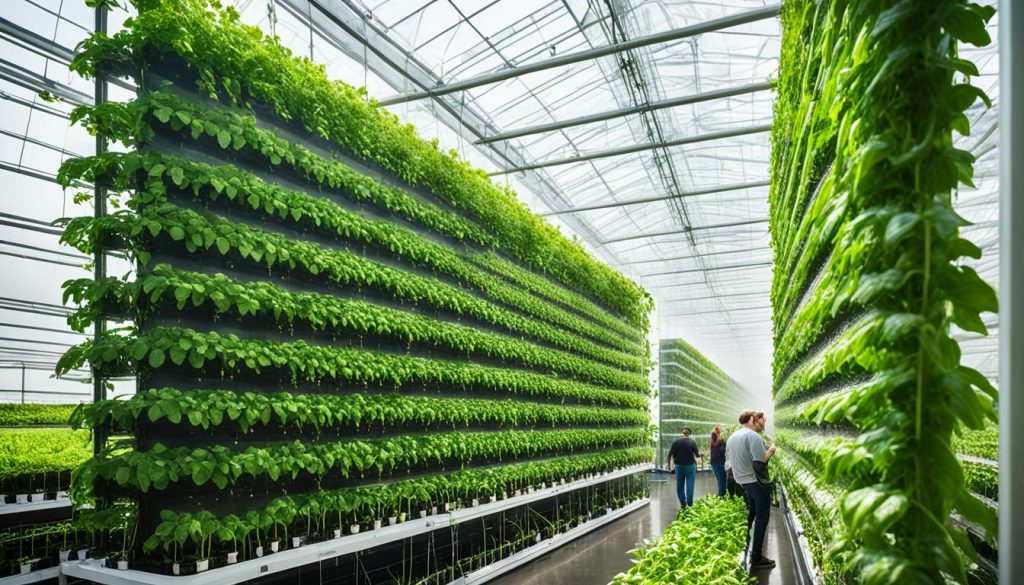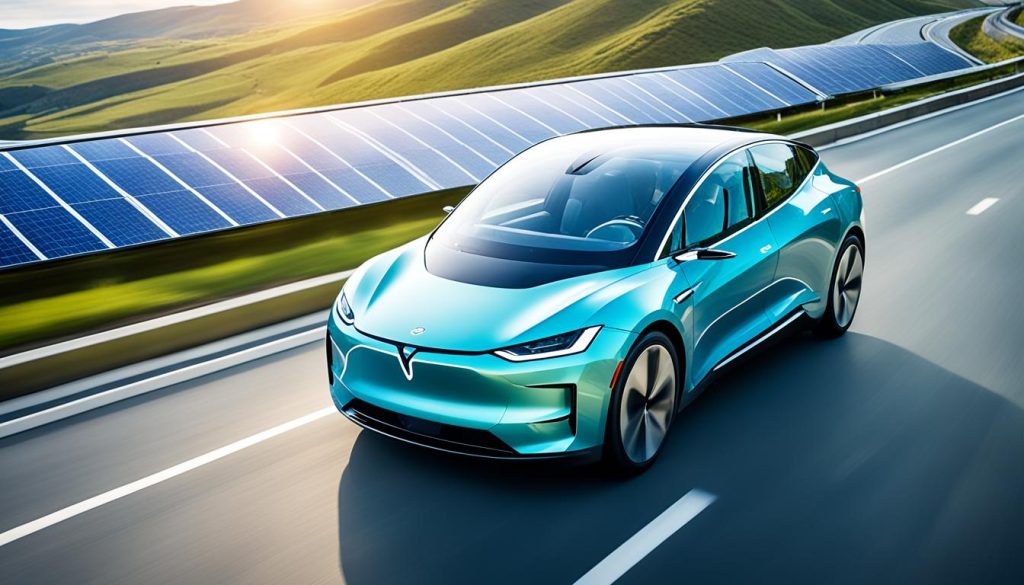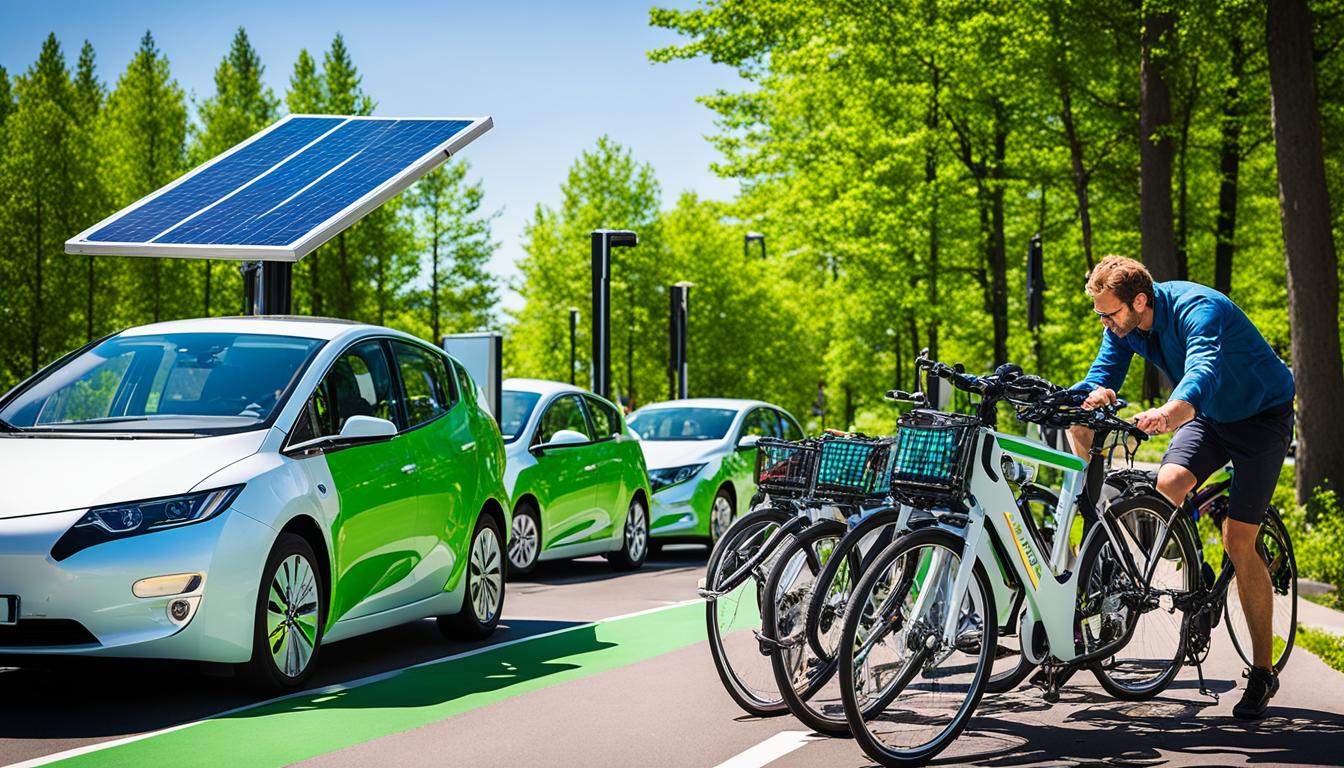In today’s world, there is an increasing demand for technological advancements that promote sustainability and protect the environment. Green technology, also known as clean technology or environmental technology, refers to a range of products, techniques, and processes designed to provide sustainable energy solutions while minimizing negative environmental impacts. From renewable energy breakthroughs to eco-friendly advancements, green tech innovations are revolutionizing our lives and paving the way for a more sustainable future.
Key Takeaways:
- Sustainable energy solutions are in high demand to address environmental challenges.
- Green technology provides eco-friendly advancements and promotes a more sustainable future.
- Renewable energy breakthroughs and environmental technology developments are shaping the green technology landscape.
- Clean energy solutions and sustainable technology trends are contributing to the reduction of negative environmental impacts.
- Green technology advancements have the potential to create a better future for generations to come.
What are Green Technologies?
Green technologies, also known as clean technologies or environmental technologies, refer to a range of products, techniques, and processes designed to provide sustainable solutions while minimizing negative environmental impacts.
These technologies play a crucial role in protecting the environment by reducing greenhouse gas emissions, promoting renewable energy sources, and minimizing the use of fossil fuels.
Green technologies can involve various approaches, such as:
- Utilizing clean energy sources like solar or wind power
- Developing eco-friendly materials and products
- Implementing waste reduction and recycling strategies
- Creating energy-efficient buildings and infrastructures
- Designing sustainable transportation systems
By adopting green technologies, we can address the negative environmental impacts associated with traditional practices and pave the way for a more sustainable future.
“Green technologies are a critical component of our efforts to transition to a more sustainable society. These innovative solutions allow us to meet our needs while minimizing harm to the environment and preserving valuable resources.”
– Jane Jensen, Environmental Scientist
Reducing Negative Environmental Impact
One of the primary goals of green technologies is to minimize the negative environmental impact caused by human activities. This includes reducing air and water pollution, conserving natural resources, and mitigating climate change.
For example, the use of renewable energy sources like solar and wind power reduces greenhouse gas emissions and decreases reliance on fossil fuels, which contribute to global warming. Additionally, sustainable waste management practices, such as recycling and composting, help reduce landfill waste and conserve raw materials.
Green technologies are continually evolving and finding innovative ways to address the environmental challenges we face. From advancements in solar energy to sustainable transportation solutions, these technologies are shaping a more sustainable and resilient future.
| Green Technologies | Benefits |
|---|---|
| Solar Energy | Renewable, reduces reliance on fossil fuels |
| Wind Power | Zero-emission energy source |
| Electric Vehicles | Reduces carbon emissions in transportation |
| Green Architecture | Energy-efficient buildings, reduced environmental impact |
| Sustainable Packaging | Reduces plastic waste and pollution |
How Do Green Technologies Help Protect the Environment?
Green technologies play a crucial role in protecting the environment by reducing greenhouse gas emissions, promoting renewable energy sources, and minimizing the use of fossil fuels. By harnessing renewable energy sources such as solar and wind power, you can significantly reduce your carbon footprint and lessen your dependence on non-renewable energy sources. These green technologies contribute to a cleaner and healthier planet for future generations.
One of the key ways green technologies protect the environment is by reducing greenhouse gas emissions. Traditional methods of energy production, like burning fossil fuels, release harmful gases such as carbon dioxide into the atmosphere. This contributes to climate change and its adverse effects. By transitioning to renewable energy sources, we can reduce our reliance on fossil fuels and minimize the release of greenhouse gases.
Renewable energy sources such as solar and wind power provide clean and sustainable alternatives to traditional energy sources. Solar energy harnesses the power of the sun, converting it into electricity without emitting greenhouse gases. Wind power, on the other hand, uses turbines to harness the energy from the wind, producing electricity in an environmentally friendly way.
In addition to renewable energy sources, green technologies also help minimize the use of fossil fuels. Electric vehicles (EVs) are an excellent example of this. Unlike traditional vehicles that run on gasoline or diesel, EVs run on electricity, reducing the demand for fossil fuel consumption. By switching to electric vehicles, you can contribute to a significant reduction in greenhouse gas emissions and promote a cleaner transportation system.
| Green Technologies | Environmental Benefits |
|---|---|
| Solar Energy | Reduces reliance on fossil fuels and decreases greenhouse gas emissions. |
| Electric Vehicles | Minimizes the consumption of fossil fuels and promotes zero-emission transportation. |
| Sustainable Packaging | Reduces waste and pollution by using eco-friendly materials and reducing the use of non-recyclable plastics. |
Another aspect of green technologies is sustainable packaging. Sustainable packaging aims to minimize waste and pollution by utilizing eco-friendly materials and reducing the use of non-recyclable plastics. By opting for sustainable packaging solutions, we can significantly reduce the environmental impact associated with packaging waste.
Green technologies not only protect the environment but also pave the way for a more sustainable future. By embracing these technologies and making conscious choices in our energy consumption and daily practices, we can contribute to a cleaner and healthier planet for ourselves and future generations.
In conclusion, green technologies offer effective solutions to protect the environment and combat climate change. By reducing greenhouse gas emissions, promoting renewable energy sources, and minimizing the use of fossil fuels, these technologies play a vital role in shaping a sustainable future. Embracing green technologies is not only beneficial for the environment but also for our overall well-being. It is essential that we continue to innovate and implement these technologies to create a greener and more sustainable world for all.
Innovation #1: Solar Desalination
Solar desalination is a green innovation that harnesses the power of solar energy to desalinate saltwater, providing a promising solution to address critical challenges such as water shortages, desertification, and hunger. By using sustainable and environmentally friendly technologies, solar desalination projects are transforming the accessibility and availability of clean water worldwide.
One notable company in this field is Elemental Water Makers, which is implementing solar desalination projects across the globe. Their innovative approach relies on the utilization of solar energy to power desalination systems, leaving behind a minimal carbon footprint and ensuring a reliable water source in arid regions.
“Solar desalination’s ability to transform saltwater into freshwater through renewable energy sources like solar power is crucial in mitigating the impact of water scarcity and combating desertification. It offers a sustainable solution to regions that face water shortages, thereby contributing to the fight against hunger and improving the livelihoods of communities in otherwise inhospitable environments.” – Environmental Expert
Although solar desalination faces challenges such as high initial costs and energy intensity, ongoing innovations are driving significant advancements in technology and making the process more efficient and economically viable.
Implemented properly, solar desalination has the potential to ensure a continuous supply of freshwater, reducing reliance on scarce water resources, and alleviating the impact of water scarcity on communities and ecosystems.
| Key Benefits of Solar Desalination | Impacts |
|---|---|
| 1. Sustainability | Reduces reliance on finite water resources and minimizes the negative environmental impacts associated with traditional desalination methods. |
| 2. Energy Efficiency | Harnesses renewable energy sources, such as solar power, to power desalination processes, reducing carbon footprint and dependency on fossil fuels. |
| 3. Accessibility | Provides affordable, safe, and reliable drinking water to regions with limited access to freshwater sources, promoting public health and well-being. |
| 4. Scalability | Offers scalability, allowing for the implementation of large-scale solar desalination projects to meet the increasing global demand for freshwater. |
Innovation #2: Green Architecture
Green architecture, also known as sustainable or eco-friendly architecture, focuses on designing buildings with minimal negative impact on the environment. By incorporating innovative features and technologies, green architecture strives to create energy-efficient buildings that reduce energy consumption and carbon emissions. Companies like Apple, Google, and Microsoft have embraced green architecture as part of their commitment to sustainability.
Features of Green Architecture:
- Proper Insulation: Green buildings utilize advanced insulation materials to prevent heat transfer, reducing the need for excessive heating or cooling.
- Energy-Efficient Lighting: Energy-efficient lighting systems, such as LED lights, are installed to minimize electricity consumption.
- Renewable Energy Systems: Installing renewable energy systems, like solar panels or wind turbines, allows buildings to generate their own clean and sustainable energy.
- Water Conservation: Green architecture integrates water-efficient fixtures and technologies, such as low-flow toilets and rainwater harvesting systems, to reduce water consumption.
- Sustainable Materials: The use of eco-friendly and sustainable materials in construction minimizes the environmental impact and promotes resource conservation.
“Green architecture strives to create energy-efficient buildings that reduce energy consumption and carbon emissions.”
Through a combination of these design principles, green architecture offers numerous benefits. Not only does it contribute to a healthier and more sustainable environment, but it also provides economic advantages, promoting long-term cost savings through reduced energy consumption and increased efficiency.
Innovation #3: Vertical Farming and Hydroponics
Vertical farming and hydroponics are two innovative green technologies that are revolutionizing agriculture and food production. With the increasing demand for sustainable agriculture and local food sources, these methods offer practical solutions for urban areas. By utilizing vertical space and eliminating the need for soil, vertical farming and hydroponics optimize resource utilization and minimize environmental impact.

Vertical farming involves stacking plants in vertical columns or shelves, creating a multi-layered system that maximizes space efficiency. By controlling the climate and utilizing artificial lighting, vertical farms can produce a consistent yield of crops throughout the year, regardless of external seasonal variations. This method allows for the cultivation of a wide variety of crops, from leafy greens to herbs and even small root vegetables.
Hydroponics, on the other hand, eliminates the use of soil altogether, growing plants in a nutrient-rich water solution or an inorganic substrate. This soilless cultivation system provides plants with the necessary nutrients directly, resulting in faster growth rates and higher yields. Hydroponics also requires less water compared to traditional soil-based farming methods, making it more sustainable in regions with water scarcity.
These sustainable agriculture practices have numerous benefits for urban areas. The close proximity of vertical farms and hydroponic systems to urban centers reduces the need for long-distance transportation of fresh produce, resulting in fewer carbon emissions. Moreover, vertical farming and hydroponics enable year-round production, ensuring a more consistent and accessible supply of locally grown food.
Benefits of Vertical Farming and Hydroponics:
- Optimized space utilization
- Minimized water usage
- Reduced reliance on pesticides and herbicides
- Protection against extreme weather conditions
- Year-round crop production
- Promotion of local food sources
Vertical farming and hydroponics offer sustainable solutions for urban areas, reducing the environmental impact of agriculture and supporting the availability of local food sources. These innovative green technologies pave the way for a more sustainable future of food production.
Innovation #4: Wind Power
Wind power is a renewable energy source that harnesses the power of the wind to generate electricity. It is a clean and sustainable alternative to traditional energy sources, such as fossil fuels. In recent years, there have been significant advancements in wind turbine technology, allowing for more efficient and cost-effective utilization of wind power on a larger scale.
One of the most promising developments in wind power is the establishment of wind farms. These farms consist of multiple wind turbines strategically placed in areas with high wind speeds, such as coastal regions or open plains. The turbines capture the kinetic energy of the wind and convert it into electrical energy. Wind farms have the potential to generate a substantial amount of electricity, making them an essential component of a greener energy mix.
Furthermore, offshore wind farms are gaining traction as a viable option for wind power generation. These farms are located in bodies of water, typically in coastal areas where wind speeds are higher and more consistent. Offshore wind farms offer several advantages, including the ability to exploit stronger offshore winds, reduced visual impact on land, and the potential to generate more electricity due to higher wind speeds. They play a crucial role in diversifying the renewable energy portfolio and achieving climate goals.
With the continued development and expansion of wind power technologies, we can look forward to a future powered by clean and abundant renewable energy sources.
Innovation #5: Electric Vehicles
Electric vehicles, or EVs, are another remarkable green technology innovation. By using electricity as their primary power source instead of gasoline or diesel, EVs produce zero tailpipe emissions, reducing carbon emissions from transportation. Companies like Tesla are leading the way in accelerating the transition to sustainable energy with their electric vehicles.
Electric vehicles have gained significant popularity due to their environmental benefits and the advancement of battery technology. With zero tailpipe emissions, EVs contribute to cleaner air and reduced greenhouse gas emissions, making them a crucial component of sustainable transportation solutions.
EVs are not only environmentally friendly but also offer advantages in terms of energy efficiency and cost savings. Electric vehicles have higher energy efficiency compared to internal combustion engine vehicles, making them more economical to operate and maintain. Additionally, the cost of electricity for charging an EV is typically lower than the cost of gasoline or diesel fuel, resulting in potential long-term savings for owners.
Electric vehicles come in various forms, from compact cars to SUVs and even electric trucks. They are equipped with advanced features such as regenerative braking, which converts kinetic energy into electricity and returns it to the battery, further increasing efficiency.
One of the pioneers in the electric vehicle market is Tesla. Founded by Elon Musk, Tesla has revolutionized the automotive industry by producing high-performance electric vehicles that rival traditional gasoline-powered cars. Tesla’s Model S, Model 3, Model X, and Model Y have gained widespread recognition for their cutting-edge technology, impressive range, and luxurious design.
As the demand for sustainable transportation continues to grow, more automakers are investing in electric vehicle development. Major companies like Nissan, BMW, and Volkswagen have also introduced their own electric vehicle models, expanding the options available to consumers.
Benefits of Electric Vehicles:
- Zero tailpipe emissions
- Reduced carbon footprint
- Energy efficiency
- Cost savings
- Advanced features and technology
The transition to electric vehicles has the potential to significantly reduce dependence on fossil fuels and promote a cleaner, more sustainable future. With ongoing advancements in battery technology and charging infrastructure, electric vehicles are expected to become even more accessible and widespread in the coming years.
| Electric Vehicle Model | Range (Miles) | Price Range |
|---|---|---|
| Tesla Model S | 373-412 | $79,990-$139,990 |
| Tesla Model 3 | 263-353 | $35,000-$54,990 |
| Nissan Leaf | 149-226 | $31,620-$43,998 |
| BMW i3 | 153-200 | $44,450-$51,500 |
| Volkswagen ID.4 | 260-290 | $39,995-$43,995 |

Innovation #6: Plant-based Packaging
Plant-based packaging offers a sustainable alternative to traditional plastic packaging, reducing pollution and waste. As the demand for eco-friendly packaging materials grows, companies are developing innovative solutions to minimize environmental impact. One notable example is Avantium, a leading company in the field of bioplastics.
Avantium produces plant-based plastics called polyethylene furoate (PEF) from bio-based feedstocks such as sugar cane and agricultural residues. PEF is a biodegradable plastic that offers similar properties to conventional plastics but with a significantly reduced carbon footprint. By utilizing renewable resources and reducing greenhouse gas emissions, plant-based packaging is a step towards a more sustainable future.
With the rise in consumer consciousness about environmental issues, plant-based packaging has gained popularity in various industries, including food, beverages, and personal care products. Companies are increasingly adopting biodegradable plastics as part of their commitment to reducing plastic waste and promoting sustainability.
Benefits of Plant-based Packaging:
- Reduces reliance on fossil fuels: Unlike traditional plastics derived from petroleum, plant-based packaging utilizes renewable resources, reducing the consumption of finite fossil fuels.
- Lower carbon footprint: The production of plant-based plastics emits significantly fewer greenhouse gases compared to conventional plastics, thereby contributing to climate change mitigation.
- Biodegradability: Plant-based packaging materials are biodegradable, meaning they can naturally break down into non-toxic components over time, reducing environmental pollution.
- Reduced waste: By choosing biodegradable plastics, businesses and consumers can reduce the accumulation of plastic waste in landfills and oceans.
Transitioning to plant-based packaging is a tangible step towards achieving more sustainable packaging practices. By embracing eco-friendly alternatives like biodegradable plastics, companies can make a positive impact on the environment while meeting consumer demands for responsible and ethical products. As plant-based packaging continues to evolve, the future holds even more innovative solutions to reduce plastic waste and promote sustainability.
Conclusion
Green technology innovations are revolutionizing our world and paving the way for a more sustainable future. These advancements, such as solar desalination and electric vehicles, actively address environmental challenges and promote sustainable solutions. By embracing these innovations, we can create a better and more sustainable future for generations to come.
The demand for clean energy and eco-friendly advancements is growing rapidly. As we continue to prioritize green technology, the possibilities for environmental innovations are endless. Through the implementation of renewable energy, sustainable architecture, and plant-based packaging, we can reduce negative environmental impacts and mitigate climate change.
By investing in green technologies and adopting them on a larger scale, we can usher in a sustainable future. The benefits go beyond environmental preservation; green technology also offers economic opportunities and job creation. As we strive for a greener future, let us continue to support and champion these environmental innovations.
FAQ
What are green technologies?
Green technologies, also known as clean technologies or environmental technologies, refer to a range of products, techniques, and processes designed to provide sustainable solutions while minimizing negative environmental impacts.
How do green technologies help protect the environment?
Green technologies play a crucial role in protecting the environment by reducing greenhouse gas emissions, promoting renewable energy sources, and minimizing the use of fossil fuels. By harnessing renewable energy sources such as solar and wind power, we can significantly reduce our carbon footprint and lessen our dependence on non-renewable energy sources.
What is solar desalination?
Solar desalination is a green innovation that harnesses solar energy to desalinate saltwater, offering a promising solution to water shortages, desertification, and hunger. It provides affordable, safe, reliable, and fossil-free water to those in need.
What is green architecture?
Green architecture, also known as sustainable or eco-friendly architecture, focuses on designing buildings with minimal negative impact on the environment. It utilizes features like proper insulation, energy-efficient lighting, and renewable energy systems to significantly reduce energy consumption and carbon emissions associated with buildings.
What is vertical farming and hydroponics?
Vertical farming involves stacking plants in columns or shelves, optimizing space and controlling the climate, while hydroponics grows plants in water or an inorganic substrate without soil. These methods offer sustainable solutions for urban areas, reducing the need for transportation and supporting local food sources.
How does wind power contribute to a greener energy mix?
Wind power is a renewable energy source that uses the wind to generate electricity. Advancements in wind turbine technology have allowed for the harnessing of wind power on a larger scale. Offshore wind farms have the potential to contribute significantly to a greener energy mix and reduce greenhouse gas emissions.
What are electric vehicles?
Electric vehicles, or EVs, are vehicles that use electricity as their primary power source instead of gasoline or diesel. They produce zero tailpipe emissions, reducing carbon emissions from transportation.
What is plant-based packaging?
Plant-based packaging offers a sustainable alternative to traditional plastic packaging. It is made from plant-based plastics called polyethylene furoate (PEF) which are produced from bio-based feedstocks like sugar cane and agricultural residues, significantly reducing greenhouse gas emissions.
How do green technology innovations contribute to a sustainable future?
Green technology innovations are revolutionizing our world and paving the way for a more sustainable future. From solar desalination to electric vehicles, these advancements are actively addressing environmental challenges and promoting sustainable solutions. Embracing these innovations can help create a better and more sustainable future for generations to come.







